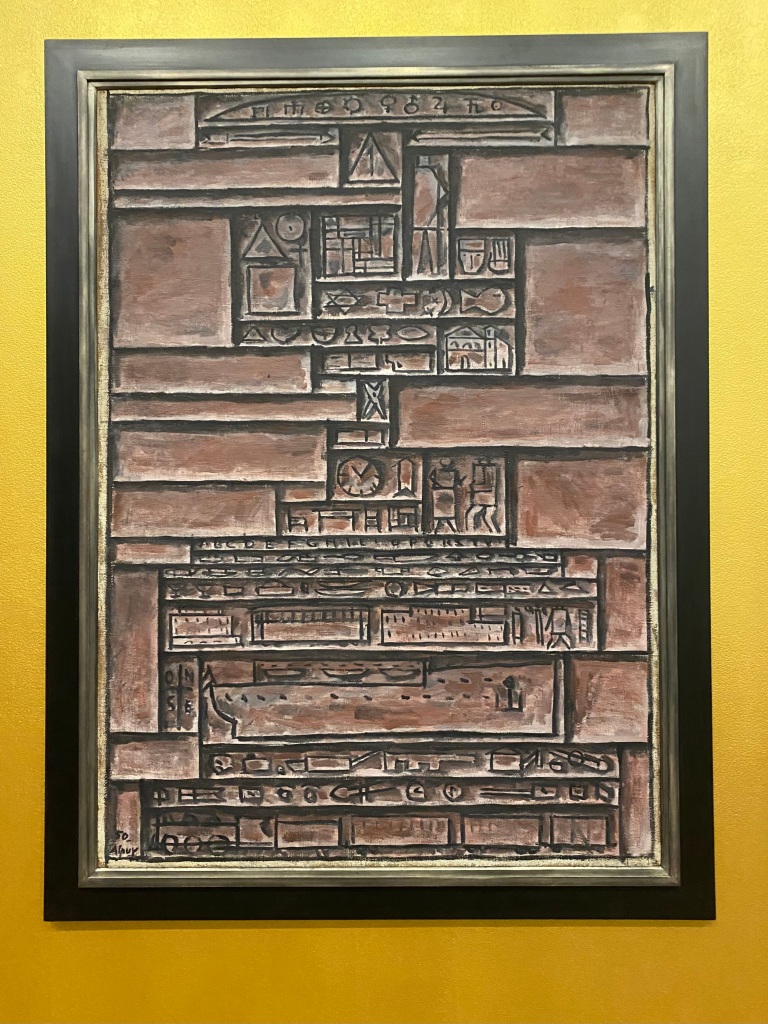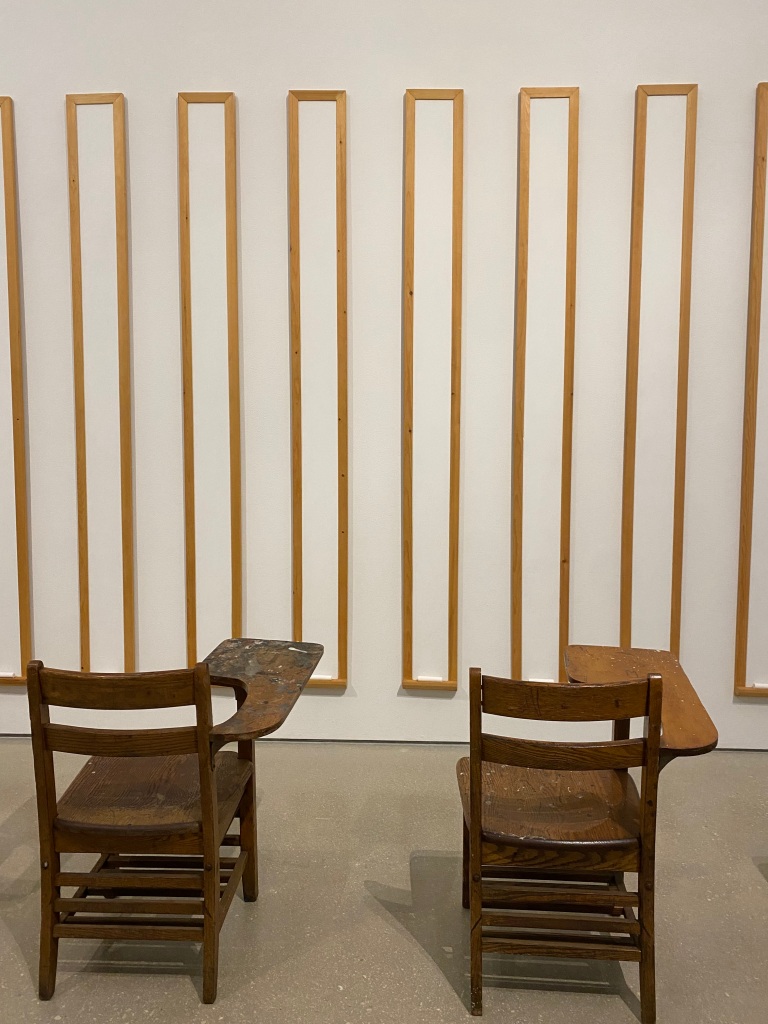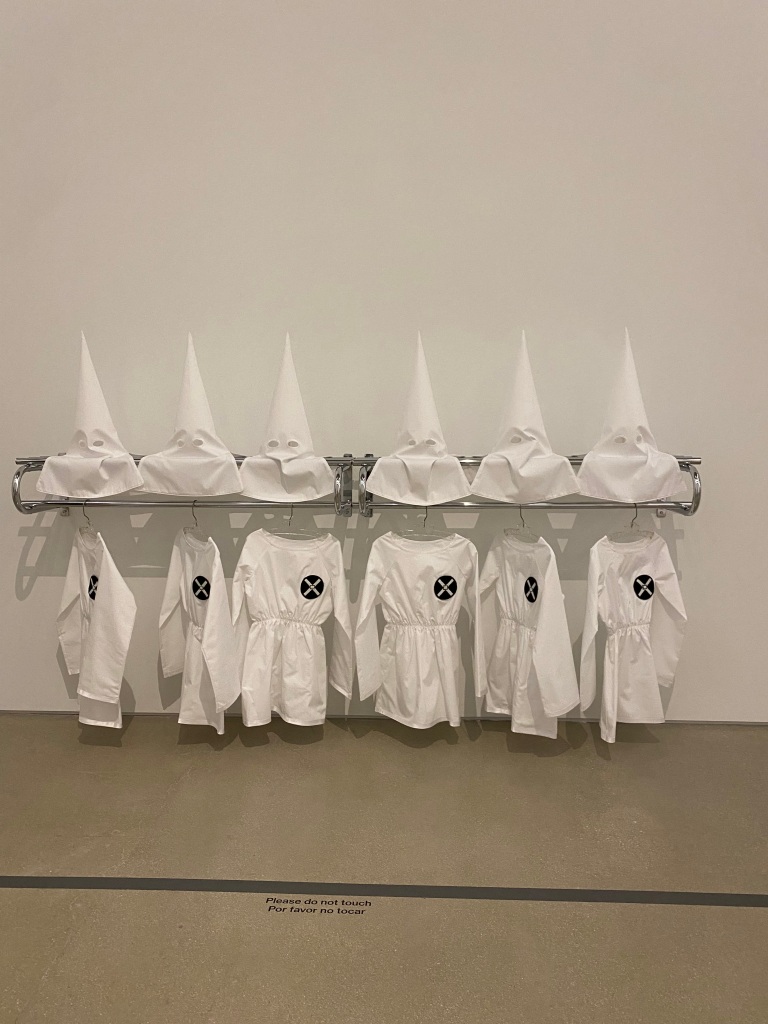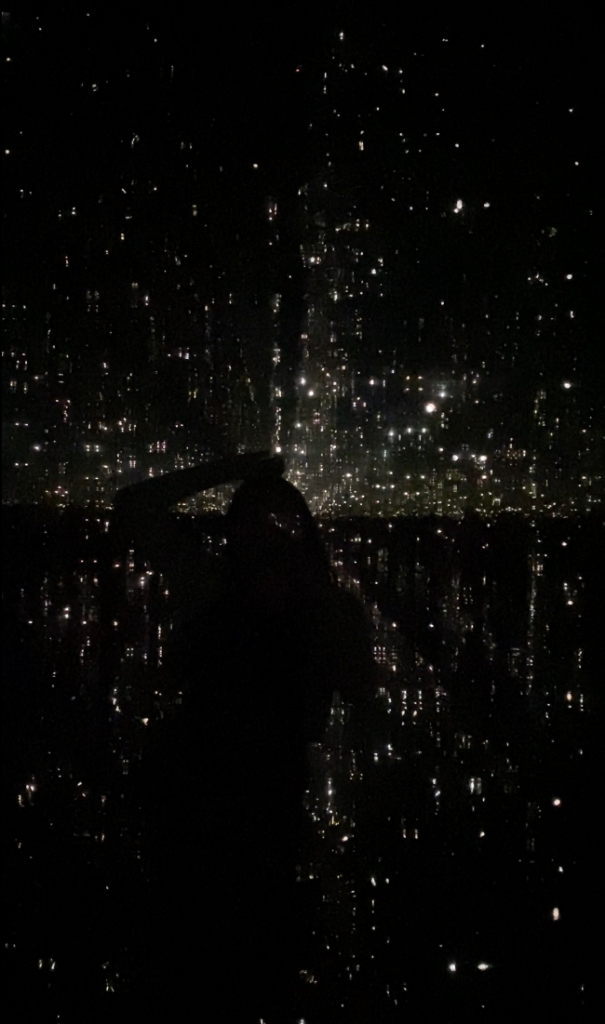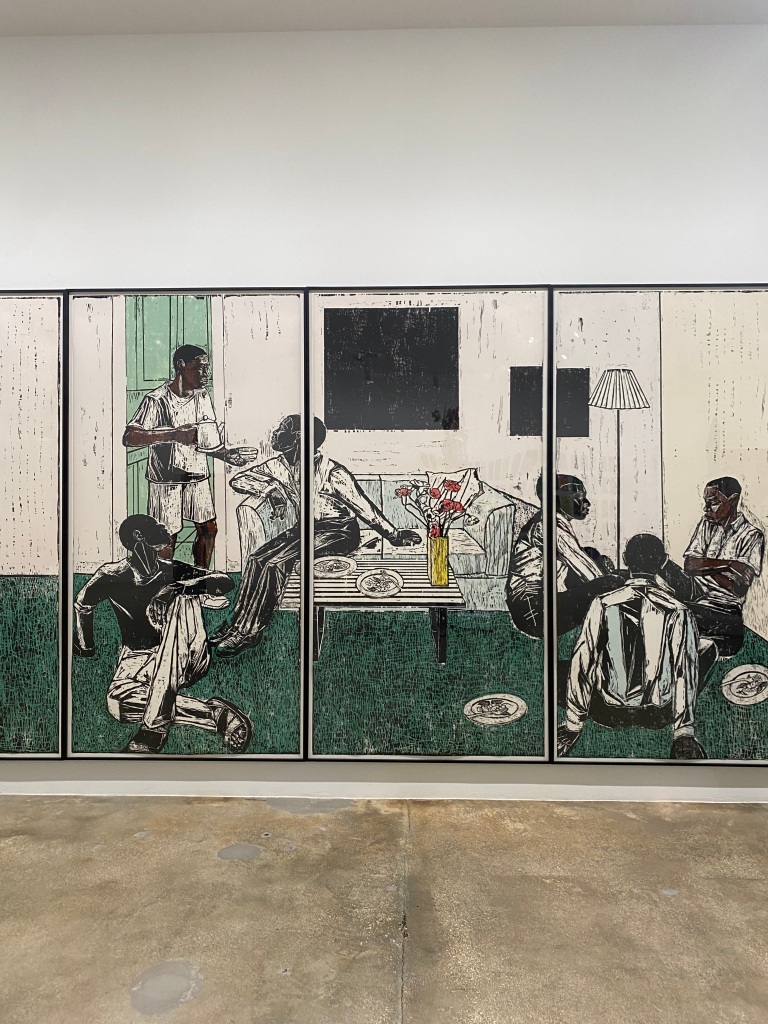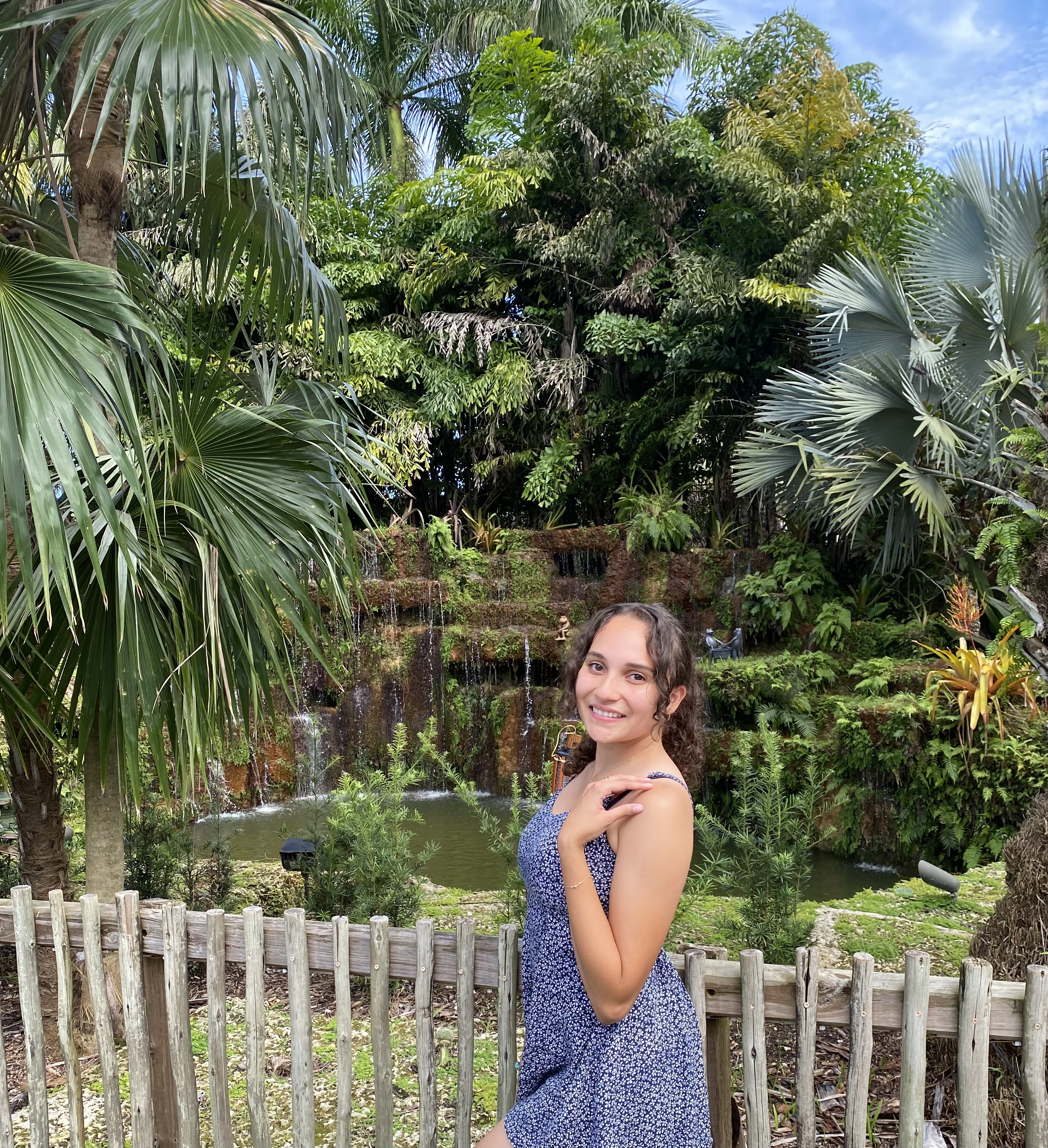
Bianca McQueen is a junior at Florida international university who is pursuing a bachelor’s in marine biology. She loves anything to do with outdoors, animals, to paint, and watch sunsets. She is a transfer student from Chicago. She chose marine biology because she is passionate about rescue and rehabilitation of marine mammals. She’s always ready for a new adventure and trying new foods.
———-
Art Final Reflection as Text
“Artist Intentions” By Bianca McQueen at Florida International University April 21, 2024

(Photos by Bianca McQueen/CC BY 4.0)
As I reflect back on this semester, the conversations, and stories we heard, all have left an impression on my heart and appreciation for art. Going into this class as a Marine Biology major and no real experience in the art community, I was unsure of the class would fully hold my interest and what I would take away from it. But as I’ve come to realize, art surrounds us in every aspect of our live, some obvious and some not. My pre assumptions of contemporary art was that it was fully interpretive and up to the viewer to choose the story, but this is also false. I’ve realized that they do have intentions and often times a beautiful story that is hidden within each detail.
A story that evolved over the process of just observing was at the Frost Art Museum by Hung Liu. At first glance you see the love affection between a protective figure and the baby along with beautiful flowers and carriages along the bottom. Before this course I would simply glance at an art piece for a few seconds and then keep walking. I would determine its beauty within the first few moments of looking at it and I wouldn’t even read the signs giving some background. I viewed art as simply something to admire but not necessary a story and lesson. When we were at the Frost Art Museum, I stopped to look at Hung Liu’s piece for a few minutes, I noticed the astonishing colors, the usage of light and shadows, and the protectiveness of the guardian over the young baby. I started to develop my own story, a grandma with her grandchild who is showing her the beauty of the world she is new to. She could be telling her stories of her own past and admiring the future that the baby holds. I thought the colors of the flowers stood out the most along with the beautifully depicted phoenix on the baby’s head. When we all came back as a group to hear from an educator at the museum she started to develop the true intentions of Hung Liu, it represents her mom along with the migration of her family and the appreciation of her old home. She also included the Mood Goddess looking at a moon to show the longingness for home. Each detail adds to her overall message and story. The one I came up with while looking at it for a few minutes didn’t fully captivate the artist’s intention. But when we took even more time to learn about the history of the artist and her purpose, the story evolved into something even more magnificent.
This class has challenged all my assumptions of art. Art can make people feel deeply, connect people, and raise awareness to social injustices. It’s a window into the soul of the artist and an escape for the viewer. Art is unique in the fact that it can be used in all careers and life paths. My biggest take away from this course is how to truly take in and admire pieces of artwork. How to not just look at it surface level but also understand the artist, point in time it was made, and the artist intention of making it. Often the idea contemporary art is linked to the notion that it is simplistic and without skill. For example, when people look at a piece done by Pablo Picasso, they say they could do it, but what they don’t understand is they could do it because Picasso already did it. He created an art style that no one had done yet, he was an innovator. One of my favorite conversations from this course took place at our first class together at the Norton Museum. Where we got a crash course in early European art, and we saw many impressing pieces that followed a specific tradition. So, when we saw Picasso’s work many were unimpressed and deemed it not very skillful. But our professor remined us that up to that point no one shift out of those traditions into a space that challenged the norm the way Picasso did. And his ability to escape that box has led to Cubism styles that we see in contemporary art today.
If I ask myself the same question of what comes to mind when I think of contemporary art my answer would be story tellers and innovators. Each single piece we saw through this course has taught me something and each were done in unique ways. Now I can look at an artwork and be critical of it in a way that leads to understanding the artists story and intention that would help me develop a well-rounded admiration for the piece.
———-
PAMM as Text
“History Through Art” By Bianca McQueen at Florida International University March 31, 2024
(Photos by Bianca McQueen/CC BY 4.0)
Through this course I have come to realize that I appreciate art the most when it was an inspiring or meaningful story and narrative behind it. This was seen throughout the Perez Art Museum. A common theme of contemporary art is the fact that it doesn’t only represent or give superiority to European art the way that the traditional art world does. Instead, it’s a reflection of current events and allows other cultures styles to be admired. PAMM is filled with many complex styles, mediums, and stories.
We started with a piece called “Arte Constructivo” by Juilo Alpuy which is inspired by the theories of Constructive Universalism. Which is the idea that the world should be organized to promote human experiences that are based on unity and are universal. That even if its not specific directed towards a person they could still find a meaningful experience through it and helps enforce unity. Through Alpuy’s piece he is representing Uruguay traditions that are specific to his culture but is universal because individuals could relate it back to something of significance in their own life. Towards the top of the work there are two heads one that represent a man and one that represents a lady which could play into the idea of universal love or relationship. Another reason this piece stood out to me is the use of only three colors, red, blue, and yellow. Which is his way of deepening the complexity of his work and going back to the stylistic traditions of Latin America.
The theory of Constructive Universalism is also seen in Joaquin Torres Garcia’s piece tittle “Construction con dos mascaras.” In which he displays ancient symbols that are from the Americas that have influence from the Mayan, Aedan, and Native American cultures. This piece was extremely unique from the ones we have seen thus far. It gives respect to underrepresented art traditions by depicting them in a way that shows their importance and beauty. A reason he did this is to stimulate a feeling of unity between people of different cultures and to advocate for the significance of the history of the Americas.
My favorite aspect of this course is the ability to have unfiltered conversations about “controversial” topics. But these topics need to continue to be in the forefront of conversation and action. This idea was seen in Gary Simmons’s “Public Enemy” exhibit. Simmons is extremely talented with different mediums and as a unique ability to tell an impactful story. The name “Public Enemy” was inspired by a hip hop group that were known for their political messages against racism but is also a metaphor for the idea that African American people, specifically men, are seen as an antagonist against society in the eyes of some people and the media. To bring awareness to this narrative Simmons artwork sheds light on different aspects and stereotypes. An aspect that gave me goosebumps was the way that certain ideologies are taught to children in schools at a young age was shown. The desks Infront of a white chalk board with white chalk was a metaphor of white supremacy ideas that written in plain sight in our education systems. This was paired with a closet rack for kindergarten aged students which hung KKK garments, as a reminder of the racial injustices that are rooted in the foundation of the US government. And enforces the notion that these racial prejudices are taught, so in order to make a change we have to get to one of the roots of the problem which is our school systems.
To end our day, we became artist ourselves and found inspiration from all the materials around us. It reminded me of the importance of being creative and having an outlet to produce something. My “zine” wasn’t perfect nor looked amazing but the process of making it was satisfying enough for me, along with seeing what my peers made. PAMM displayed very unique art that once again told beautiful and impacting stories that made me reflect and ponder.
———-
Rubell Museum as Text
“Valuable Reminders Through Art” By Bianca McQueen at Florida International University March 17, 2024
(Photos by Bianca McQueen/CC BY 4.0)
The art in the Rubell museum told beautiful and impacting stories. We started our journey by escaping into Yayoi Kusama’s room, “Where the Lights in My heart Go” the lights reflection on the mirrors strangely remined me of being in the night life in downtown Chicago. It brought me back to being in my home city where the lights of the buildings at night were apart of its beauty. Linking this feeling to the name, my heart went home for the 30 seconds I was in the small room. Because of this I can only infer that Kusama hoped to bring people back to a place or thought that is deep within them. It’s subtle and simple yet the feelings it evokes is complex. This something that I find precious and unique about art and was seen all throughout the Rubell museum.
Another reason why contemporary art is beautiful is the fact that it brings inclusivity and sheds light on typical stereotypes. The large portrait of people of color sitting in an urban area doing ordinary activities was unique in the way that, a lot of the time, artwork with people of color is embolizing fighting or something bad. Instead, they were all comfortable and seemed to be enjoying each other’s company, a picture that would usually be shown with white people. An interesting juxtaposition to this would be the parents hugging their child that has a backpack. The obvious story is that the child is going off to school, but the antlers that were added offer an entirely different story and feeling. Instead, the antlers could signify that these people are being “hunted” and the child is now in danger by being in the world and being a person of color. These two paired together offers a full story of what a lot of people have to go through based on skin color. At home the child is safe and protected but in the world the child could face dangers that are due to an unjust system.
The idea of being desensitized to the unjust system is seen through Untitled by Christian Boltanski. This piece represents the essence of how overtime victims and survivors are forgotten or even overshadowed by the disaster that happened to them. Untitled exhibits photos of children that died during the Holocaust, whose picture is being blurred by the light above the. Once again, the piece itself is simple but the story gave me goosebumps. As a society we have gotten “used to” violence and crime when we hear it, it doesn’t shock us. When we a taught about wars, death, and murder in school we are simply told the facts and its often sugarcoated. But this piece is a reminder that events that took place during the Holocaust should shock and disturb us. What we hear on the news should make us realize that violence isn’t something we should be used to but instead stand up against.
Up to this point in our class we hadn’t fully heard the craziness of the art world behind the scenes. Ibett Yanez del Castillo and Daniel Clap at the Emerson Drosch gallery gave us a full and unfiltered idea of the true patient and dedication it takes to be a part of the art industry. Ibett touched on how no day is alike and that her work doesn’t stop when she gets home but instead it’s never ending filled with competition and tough decisions. Daniel helped us understand how difficult it is to transport and install large pieces, an idea I forget when simply enjoying the art. Overall visiting both places led to great conversations that were open and honest.
———-
Art Wynwood as Text
“Unique Stories” By Bianca McQueen at Florida International University February 2, 2024
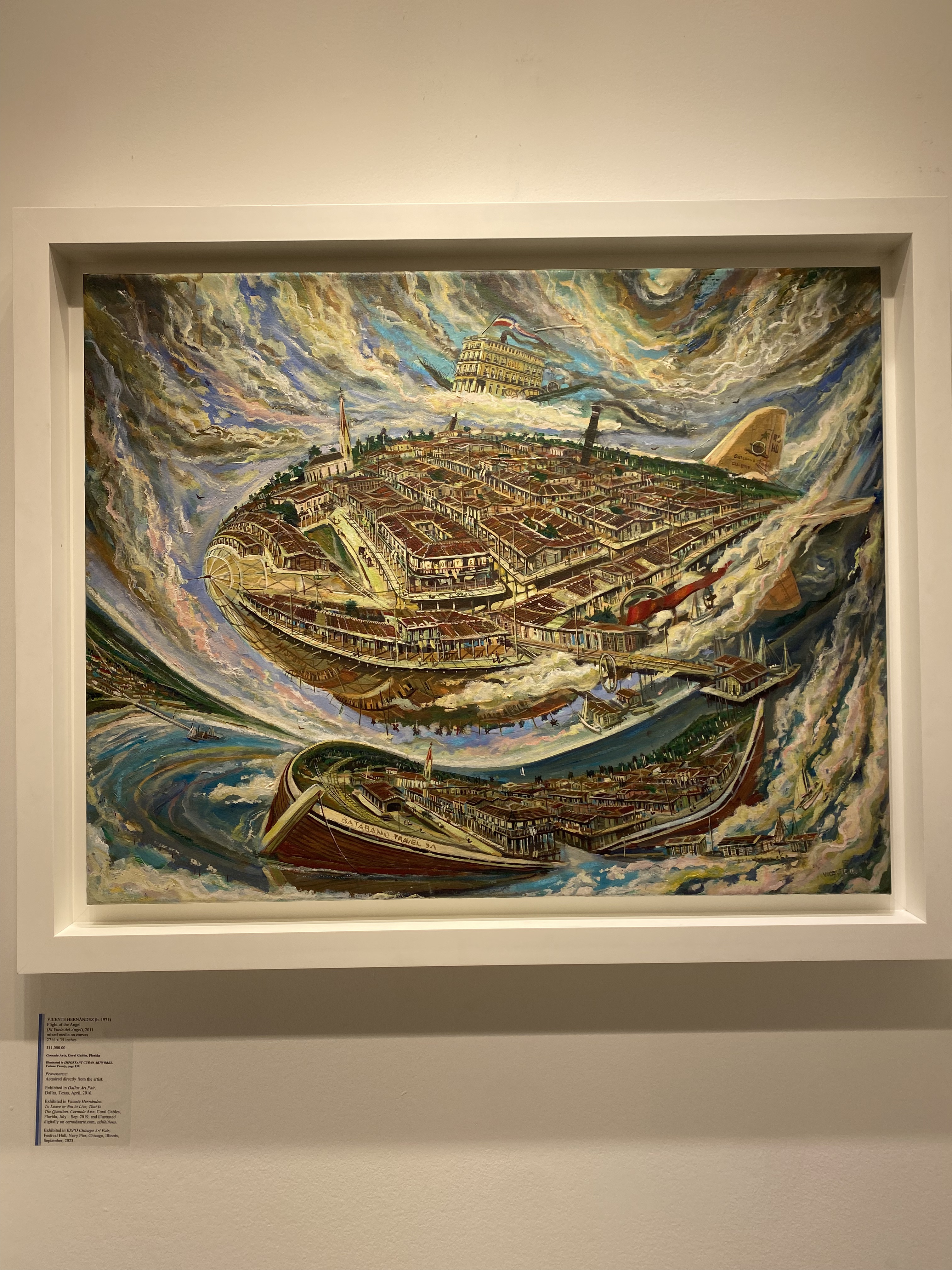


c
Typically, art shows and exhibits aren’t top on my list of things to do in my spare time. During Miami in Miami, we went to art Untitled, and this experience changed my mind for that. So, because of it I was excited for Art Wynwood and for the chance to continue meeting working artist. The best part of this class for me has been being able to see art through the perspective of those who made it, and ones why truly know the meaning and history. For a while I thought that contemporary art was only supposed to be interpreted from the view and that it didn’t already come with a story or meaning. This was show greatly at Art Wynwood and the pieces we saw.
A piece that stuck with me the most is called the Flight of the Angel by Vicente Hernandez. When looking at the artwork, typical of contemporary art, you don’t see an exacting replication of something else but rather an interpretation that creates a story. Art plays a big role in revolution and political statements to show some sort of feeling or rebellion. The piece shows what seems to be a blimp flying of an entire town from Cuba to Miami. Which is a representation of the political climate Cuba has faced and the impact it has on the people. It perfectly resembles the importance of immigration and Miami has become home to many ethnic groups because of it. This connection to the city we are into art was beautiful to see and definitely left an impression.
Following the theme of escaping the artistic box to form something new is a landscape piece by Tomas Sanchez. Instead of following the “rules and laws” of art he does something different by making what seems to be a realistic artwork into something that represents a dream state. The landscape doesn’t show typical shading and light found in other pieces. But instead, he also blurs the line of reality and dream. The way did the landscape seems to be endless and like you can truly get lost in the art. At first glance I thought it was a picture because of how perfect it looks. But something else I noticed was that the trees were all the same unlike how nature truly is. They were all uniform and almost identical which also played into the idea of different states of being.
I also enjoyed that Art Wynwood showcased a little aspect of STEAM. It connected technology to Art in a very interesting why. The shifting sequins that resembled what is sometimes found on pillows and stuffed animals that changes when rubbing your hand over, was turned into a large canvas that was triggered by motion. Although it only showed the movements the viewer did, it still showed that art could be made by all forms. We were enchanted by it because we could wave and watch it follow our hands which let us be the art.
Overall, Art Wynwood was filled with impressing art that all told unique stories. It was inspiring to see artist from different places come together and for us to have the ability to admire their work. Art galleries, shows, and exhibits are starting to become something that I am excited to explore more and learn from.
———-
Margulies/ Bakehouse as Text
“Seeing Into the Mind of an Artist” By Bianca McQueen at Florida International University February 18, 2024
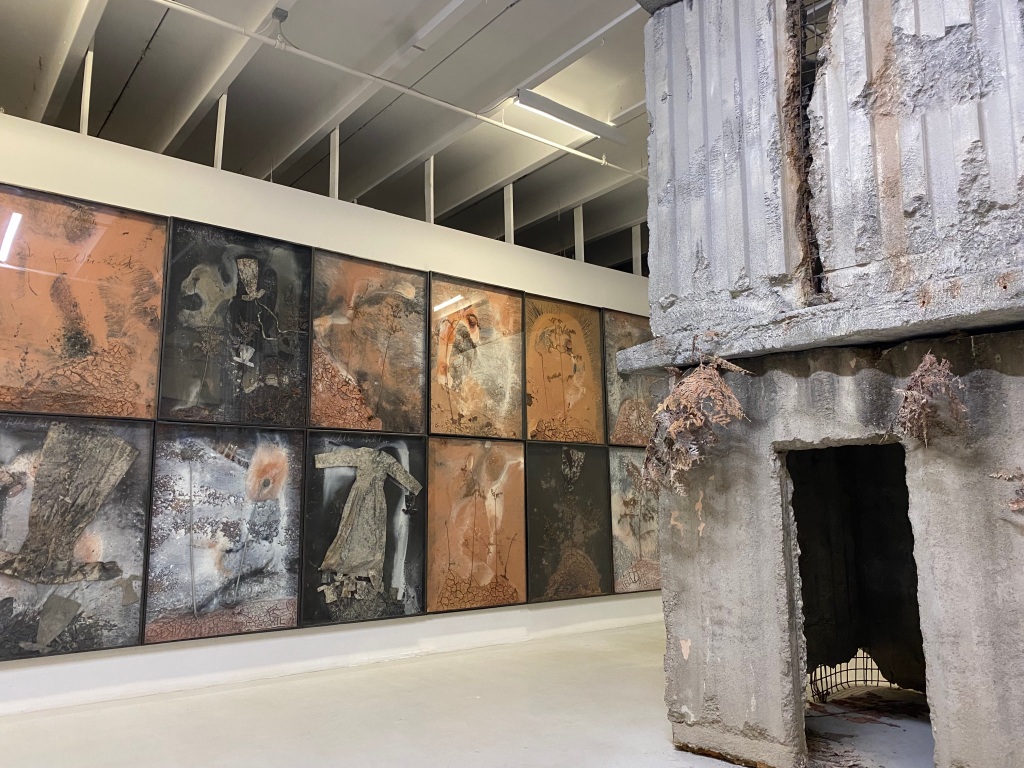
Kiefer’s Secret of the Ferns (Photos by Bianca McQueen/CC BY 4.0)
This week I felt as though I was able to see more of the mind of specific artist and why they created in the ways that they did. We have to first start with the idea that sometimes wealthy people don’t make ethical decisions with their money. Going into what seems to be a sophisticated and fancy environment is at times outputting, but in reality, Margulies is one of the rare souls that uses his fortune in a way that’s beneficial for the community. Especially to know that he not only has a welcoming space filled with world class art, but also has donated $44 million to the Lotus House Women’s shelter. Walking through the warehouse, I was able to get a sense of the respect Margulies has for creativity and community.
The story of the warehouse and the type of art Margulies enjoys unfolds in the first room we entered. The unique sculptures and pieces made by Segal where inspirational and allowed for a unique connection. The sense that there’s certain life situations we have all faced, such as being lonely at a bus stop or park bench but surrounded by other people. Throughout the course so far, we’ve touched on the fact that what makes an artist successful is being able to create something that is outside of the norm and may seem obvious to us now but during their time it was groundbreaking. Segal’s pieces were among my favorites because of the simplicity of the designing and process but the complexity of the stories he portrayed were spectacular. Through the little and big details, the story perfectly unraveled, and I felt like I could see into his mind and what he truly wanted us to take away.
The next artist that left a last impact through his art and story was Kiefer. The large concrete structures that were displayed told the story of his childhood in Germany after World War Two in an impressive way. Once we started to hear the history the pieces of his art started to come together to tell a story that needs to be heard from a perspective I’ve never thought of. We are taught a lot about World War Two and the events that happened, but rarely we hear about the aftershocks for the generations to come. Kiefer illustrates something we all unfortunately have learned, the concentration camps and gas chambers. But he also displays the way the playgrounds looked and the rubble that filled it. He partners the structures with 48 extremely large pieces that have actual ferns and terracotta. Each individually tell a beautiful story and when looking at them as a whole it was breathtaking. Because of the ways that Kiefer connected his real-life experiences and events we all know to make an installation, it allowed me to have a better sense of who Kiefer is and the stories he wants to unveil.
When visiting the Bakehouse, I was inspired by the various processes that artist go through to make a piece. Since I’m not an artist myself it was hard for me to understand how the artist, we learned about physically started their pieces. To make such beautiful artwork you have to start somewhere, and the Bakehouse was a representation of a starting point. The artist we met we kind and allowed us into a part of them that, I can only guess, is extremely vulnerable and private. To see their process and how they begin gave me an even greater love for art and the artist themselves.
———-
Norton Museum as Text
“Freezing Time” By Bianca McQueen at Florida International University January 28, 2024
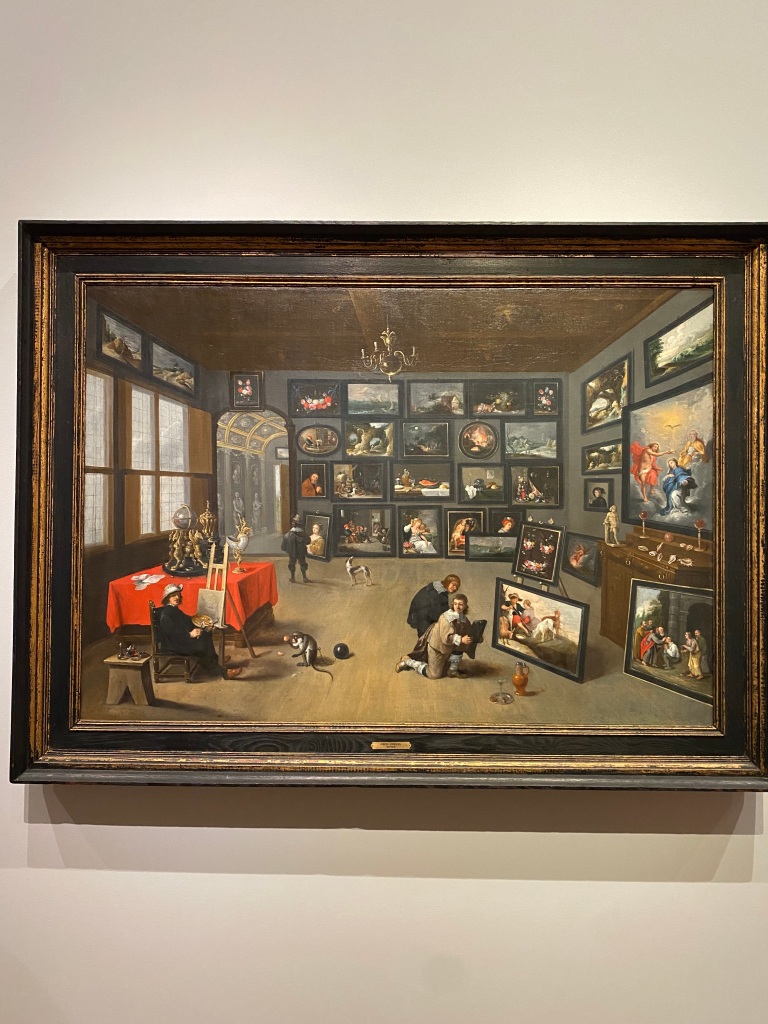
The Original Picture of A Picture (Photos by Bianca McQueen/CC BY 4.0)
I’ve never thought of art as a way to freeze time the same way that a photograph does. To me it was just a recreation of something visual or what the artist makes up. The story that stuck with me is the lady who took a piece of chalk to draw an outline of her partner based on his shadow who was soon going off to war, as a way to remember him. The same way that we would take a picture to cherish. At the core of art, it’s a way to keep a moment alive forever. This was brilliantly shown as we walked through Norton. It was like walking through hundreds of frozen moments that have remained the same for hundreds of years.
The Norton Museum gave us an art history lesson all in one from pieces from Chinese Dynasties, through Europe during the Renaissance and Baroque times, through groundbreakers such as Van Gogh and Picasso all the way up to contemporary art. To see the four depictions of Mary and Jesus through different styles and eras offered a better idea of how art has evolved. We started with The Madonna and Child in Majesty from around 1300, which to my eye was simplistic in shapes and colors. Then going to The Coronations of the Virgin with Saint 100 years latter was similar yet unique to show the progression of artists during this time. The Madonna and Child in glory and The Immaculate Conception are the images that conjure in my head when I think of paintings of Mary. When comparing the four paintings and doing the body poses in class gave me a better understanding of how artist started to develop images in a more realistic way to convey emotions and stories.
Ones that stood out to me were the lighting and shading techniques in the Baroque paintings. Those truly felt as though they were a window into what was happening in that room or space. The way that it represents what was going on in that time period because the lighting came from a candle that gave the room a special ambiance was beautifully shown through these pieces. Through the museum I loved seeing the skills that humans are capable of. The way that artist like Picasso and Monte were so openminded and turned what they visualized into art that then revolutionized the next years in the art world. We saw in the Chinese Dynasties that pieces were made from imagination through the casting of a dragon with other creatures. To then a more realistic turn of painting moments of biblical history. That then turned into wealthy people paying artist to paint their portraits as a way to be remembered. Each individual piece of artwork was unique even if it was during the same time era or followed the patterns of techniques.
The art history lesson at Norton opened my mind to contemporary art. Before, I saw it as simple and unskilled since it doesn’t show a true picture but instead has to be interpreted. I always thought that historical biblical pieces and European art shows the most skills. Which has now been disputed because contemporary art is just as skillful and challenges the artist to not stick to a set of rules. Instead, it allows for art that continues to evolve and makes artist ask themselves what has not been done yet?
———-
Art Encounter as Text
“Appreciating Art” by Bianca McQueen at Florida International University January 18, 2024
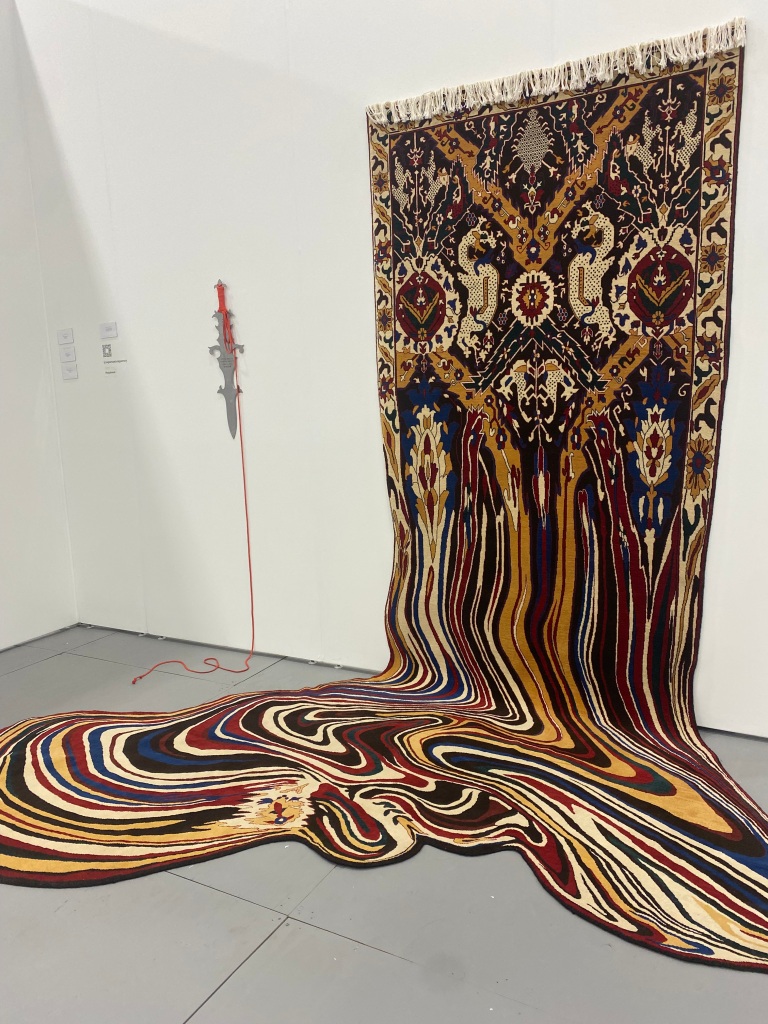
A rug that left an impression (Photos by Bianca McQueen/CC BY 4.0)
The past few months of living in Miami has been soul changing and eye opening. Coming here I had many misconceptions as to what Miami was and is. I only saw this city through the eyes of a tourist, but last semester shifted my whole perspective. I have it all to thanks to Miami in Miami, a class and journey that allowed me to make my own opinions and taught the factual history of my new home. But there is still so much more to discover, and I was inspired by Untitled Art week to continue the adventure. Art has never been my forte; it was my brothers. It has always been something that I’ve admired and been inspired by. But never something that I took time to fully learn or acknowledge.
My experience with art is from watching my brother work endless hours to reach a masterpiece. He focused on creating his own comic superhuman characters and he even majored in graphic design. He was always the artistic one and I was the outdoorsy one. Being from Chicago I’ve always known and seen a city filled with art. One of my favorite museums is the Art Institute of Chicago. If you’ve been there, you know that it feels never ending. Every wall and corner are filled with paintings, old artifacts, and even medieval swords. The first time I visited I was shocked at the medieval art section. It wasn’t only beautiful paintings but was also sculptures, machinery, and armor. It made me aware that art wasn’t only produced by putting something on a canvas or paper, it was whatever the brain could conceptualize and turn it into something physical and abstract.
Art encompasses more than we give it credit. It’s something that is timeless, will always be cherished, and taken a lesson from. I truly know nothing about the contemporary art that Miami has to offer. But when I think of contemporary art, I think of something that has a lot of different layers and components to it. It tells a story through every line and detail. It also incorporates the challenges that are being currently faced in society. I’ve also seen that it’s not always a showing of a specific thing but rather it depicts a picture that offers the viewer the ability to interpret how the feel and what they see. Art is the ability to evoke some type of emotion through what is shown. I think its impressive and takes a lot of skill to do so.
Through this class I hope to gain another perspective on art and to stretch my brain while viewing them to form my own stories. I’m excited to see Miami through another lens that stems from creativity and uniqueness. To see the parts of the city I would usually not take time to explore because isn’t my full interest. But nonetheless something that is important to learn from. To see the ways that the cultures in Miami begin to intertwine in the pieces that we see and give acknowledgement to the great brains that created it.

